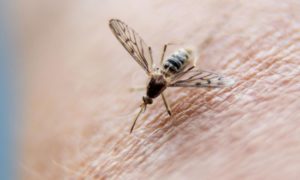
Artificial intelligence researchers have developed a mosquito early warning system that raises the alarm when the insects are near by detecting the whine of their wingbeats.
The system uses an app that can run on a £20 mobile phone to analyse sounds in the environment and issue a warning if it hears the telltale buzz as a mosquito swoops past.
While the app can already tell when the insects are close, the next step is to make it good enough to identify different species from their audio signatures, and so tell malaria-carrying mosquitoes from less dangerous ones.
“Hopefully this will save lives,” said the project’s Yunpeng Li, who works on machine learning at Oxford University. “If we can identify the species, we can tell people in areas where there is malaria that these mosquitoes are around and that they need to take care, to use bed nets and so on.”
There are more than 3,000 species of mosquitoes in the world, but only about 50 of them, all belonging to the genus Anopheles, spread the malaria parasite at dangerous levels. Following a steep decline in global malaria cases since 2010, reduced investment means infections are on the rise again. In 2016 the disease claimed the lives of 445,000 people globally, with more than 90% in sub-Saharan Africa.
To build the early warning system, the Oxford team recorded mosquitoes in the lab and gathered more audio signatures from the US Centers for Disease Control and Prevention, an army research unit in Kenya and scientists working in the forests of Thailand. They then converted the audio signals into frequency features and trained an algorithm to learn the signature pattern created by mosquitoes in flight.
Preliminary tests with inexpensive phones found that the app could detect the presence of mosquitoes from about 10cm away, depending on background noise. The system is likely to be most effective if the phone is placed in an area that is attractive to mosquitoes, such as next to a lamp.
The whine of a mosquito varies as it grows, but Li believes the algorithm can learn the telltale audio signatures produced by different species. The pitch of a mosquito’s buzz depends on how fast it beats its wings – around 300 times per second is typical – but the tone is accompanied by higher-frequency harmonics. Features such as the wing size and shape feed into the overall sound the mosquito makes.
To boost the accuracy of the early warning system, the researchers will now process 100 hours of recordings in the wild and in labs, including scores of mosquito whines. They are hoping the public will help with the task by listening to two-second audio clips and saying whether or not they can hear a buzzing sound. If they can, the clip will be fed into the algorithm, along with any details the scientists have on the species. Those wanting to take part on the Zooniverse website can train themselves first by listening to examples of mosquito whines.
Ultimately, Li wants the app to do more than protect people against malaria-carrying mosquitoes. With the early warning system, researchers could build up real-time maps of mosquito populations, and scientists in the field could identify mosquitoes more easily. In areas where mosquitoes do not carry diseases, one way of collecting them for identification is to let them bite and then suck them into a trap. “It’s slow and very bloody,” said Li.


